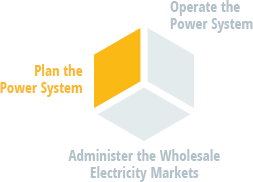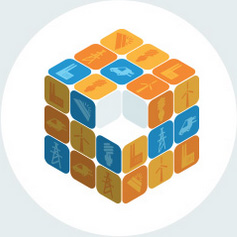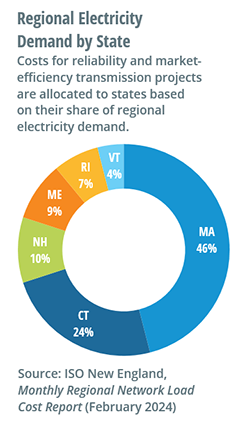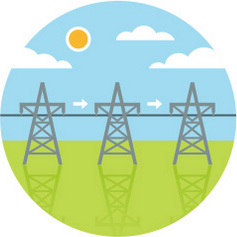Managing the regional power system planning process is one of three critical roles the ISO performs in New England.
To effectively oversee the flow of high-voltage electricity into, within, and out of New England, the ISO must make certain that the region has the power resources and transmission lines necessary to meet the demand for electricity over time. We do this by performing comprehensive system analyses and planning—and sharing that information with the marketplace to signal where new investment is needed. Because the ISO is an independent nonprofit and does not favor one resource type over another, we coordinate, evaluate, and oversee these types of power system additions objectively.
To solve power system needs, New England relies first and foremost on projects proposed from the marketplace—in other words, private investment in new power plants, transmission facilities, and other resources. If market responses are not forthcoming or adequate to meet New England’s needs, the ISO, in its role as a Regional Transmission Organization, is required to facilitate a competitive process for ensuring the development of transmission infrastructure solutions that are essential for maintaining power system reliability and an efficient wholesale electricity marketplace, or for meeting public policy goals set by federal, state, and local governments. Longer Term Transmission Planning changes approved by the Federal Energy Regulatory Commission in 2024 create an additional process that provides an avenue for the states to evaluate and finance transmission upgrades needed to ensure a reliable grid throughout the clean energy transition. (See Attachment K, Regional System Planning Process, of the Open Access Transmission Tariff.)


To meet future system needs, the ISO’s planning process must consider many different factors, such as the likelihood of power plant retirements, the expected development and integration of the region’s renewable resources, the impact of public policies on the grid, and the close interaction between the natural gas and electric power systems.
Through the ISO’s regional system planning process:
This continuous process yields a biennial Regional System Plan (RSP) that serves as a roadmap of system needs. The power system is never static, so we update the RSP to reflect the latest system conditions, forecasts, and investments in the power system.
All this information, combined with pricing signals from the markets, enables participants in the marketplace to make sound business decisions about investing in the power system—investments that help ensure the reliable flow of electricity. Informed decision making is critical to participants who, in New England’s market-based environment, carry most of the financial risk of these large-scale investments.
The RSP also includes a plan for coordinating a regional response to any additional transmission infrastructure improvements needed to maintain reliability and an efficient wholesale electricity marketplace, or for meeting public policy goals set by federal, state, and local governments. These are considered “regulated transmission solutions.”
In addition to the RSP process, the ISO conducts longer-term analyses of transmission system needs in response to requests from the New England States Committee on Electricity. The 2050 Transmission Study is the first example of such an analysis.
Continuously improving the transmission system has benefited New England in many ways—from reducing the risk of blackouts to decreasing air emissions and lowering energy costs. However, making improvements to the transmission system has many challenges:
New England has been successful in developing new transmission infrastructure for two main reasons:

For regulated transmission solutions to meet identified reliability or market efficiency needs, costs are allocated across the region on a load-ratio basis—in other words, it’s based on the amount of electricity demand in each state. For public policy projects or interregional transmission facilities, a different cost allocation is used.
The cost of projects proposed by the marketplace that are not deemed essential for power system reliability are typically borne by private investors and not eligible for regional rate recovery, just as they are for power plant and other resource development. Such projects are called elective transmission upgrades.
To learn more about the ISO’s responsibilities and process for deciding whether the region will share the costs for new transmission, see the Transmission Cost Allocation page.

ISO New England has other responsibilities in coordinating how transmission lines, power plants, and other resources connect to and operate on the grid. For example:
Our Interconnection Request Queue report is a source for information about proposed resources, projects that have been withdrawn, and projects that have begun commercial operation.

For the ISO to have a clear understanding of the capabilities of the grid, each connected asset must be registered with us. Each year, we process thousands of registrations and updates for new and existing power plants, load assets, tie lines, and demand-resource assets, as well as the entities designated by a market participant to receive ISO dispatch instructions. The ISO also conducts hundreds of audits each year to evaluate the capability and performance of resources to ensure they are able to operate as expected.
To help promote reliable operation and successful participation in New England’s marketplace, we also provide extensive training opportunities for new and existing resource owners.
Learn about the ISO’s other two key roles in New England’s electricity industry: